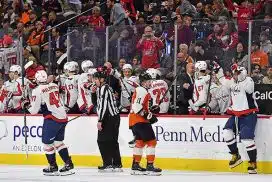By Kevin Durso, Sports Talk Philly editor
Thursday’s game against the Capitals was the Flyers 24th game of the season in a 56-game schedule. There are four games remaining until they officially hit the halfway point. As they draw closer to that mark, their identity is becoming clearer by the day.
Right now, this is a very beatable team. They manage the puck horribly. They struggle with defensive coverages across the board. They can’t solve the neutral zone half the time. On nights when they do get consistent pressure, they can’t finish.
Thursday’s game was just another example of how ugly it’s been lately. Washington didn’t have to look their best to put a stranglehold on this game. And on a night when Washington, Boston, and the Islanders all picked up two more points in the standings with wins, the Flyers fell just a little farther behind in the race. Those points are costly no matter when they are lost.
Here are five takeaways from Thursday’s Flyers-Capitals game.
1. End of Period Deficits
Remember a couple of seasons ago how the Flyers biggest problem was a consistency of falling behind in games? Sometimes it would be just allowing the first goal, but 32 times in an 82-game season, they trailed in games 2-0. You know what’s hard to do when you have to fight and claw your way back into a game? Win.
That’s one of the Flyers struggles right now. It’s not quite as bad as the 2-0 deficits in the first or early second period of games, but it’s approaching that territory.
In the last six games, just look at what the Flyers have had to overcome:
- Tuesday, March 2, in Pittsburgh. The Flyers and Penguins are tied with no scoring through the first period. The Flyers scored first, but allowed the next three goals in the period. They trail, 3-1, through two and never recover in a 5-2 loss.
- Thursday, March 4, in Pittsburgh. Three goals in a span of 1:11 give the Penguins a 3-0 lead before you can blink. Alain Vigneault calls timeout. The Flyers find a way in that game, trimming the margin to 3-1 at the end of the first and 3-2 at the end of the second before winning, 4-3.
- Saturday, March 6, in Pittsburgh. The Flyers get the first goal, then give up the next two in short order. They trail, 2-1, after one. The Flyers then get back in front in the second, but surrender a late goal to tie it up, 3-3. Pittsburgh finds the only goal of the third to win, 4-3.
- Sunday, March 7, at home against Washington. The Flyers once again get the first one and carry the 1-0 lead into the first intermission. Washington gets two goals late in the second to take a 2-1 lead. The Flyers don’t have the energy left from a busy week and Washington scores the lone goal of the period for a 3-1 win.
- Tuesday, March 9, at home against Buffalo. The Flyers score first again, then give up three goals in the first period. They trail, 3-1, after the first, get a goal early in the second and give it right back to trail, 4-2. They get another goal before the period ends, tie it up in the third, then win the game, 5-4, in a shootout.
- Thursday, March 11, at home against Washington. The Flyers fall into a 2-1 deficit at the end of the first period, then give up the only two goals of the second to fall behind, 4-1. They score twice in the third, but fall, 5-3.
In the last six games, the Flyers are 2-4-0. Even in the two wins, the only time they have led at the end of the first or second period in any of these games is the first period of Sunday’s game against Washington. Otherwise, it’s either been tied or the team has been trailing.
That’s not a formula for success. You can’t play from behind constantly and hope you find a rally.
The Flyers have already shown in the course of these two weeks that they don’t quit on a game. They have been in five of these six games, perhaps the only one feeling like a longer shot than the others is the Sunday game against Washington where you knew energy was running low. But in each of the Pittsburgh games, the game was there for the taking. One of them became a win. Same thing against Buffalo. That became a win. This game could have nearly been an overtime game at the very least as the Flyers closed the gap to one with a strong third period.
But it’s too little, too late, too often for the Flyers right now. What they do in the first 40 minutes leading up to these points in the game puts them behind the eight ball too much. It puts them in too big a hole to climb out.
That’s what happened on Thursday. Washington didn’t dominate any particular aspect of the game to the point where they looked like the top contender in the league. But the Flyers were certainly not on their level either. That’s what has them exactly where they are at this time.
2. Defensive Blunders
It feels like every game we can just take a closer look at the goals against to see the flaws of this team on full display. A closer at each of these goals, and pick out which one sounds avoidable.
Washington goes up 1-0 on a goal by Alex Ovechkin that comes off some horrible puck management. Call it a miscommunication, but Brian Elliott is just doing his job to clear a loose puck moving slowly toward the crease from the other end of the ice out of danger, so he throws it toward the boards. Ivan Provorov isn’t able to knock it down and the bounce goes back into the slot on a tee for Ovechkin.
You can look at it and feel Elliott made a bad pass and shouldn’t be playing the puck like that. You can look at Provorov and say he should knock that down and prevent the chance from even happening. Doesn’t matter which side you are on, it was avoidable.
The second goal for Washington comes on a breakaway for Conor Sheary. How does this happen? Nicolas Aube-Kubel makes a bad pass to the Washington blue line that handcuffs Travis Sanheim. Now that Sanheim is trying to control the puck and knock it down with his feet, and it gets behind him, that allows Daniel Sprong to get to it and spring Sheary. He beats Elliott five-hole, 2-1.
The third Washington goal is yet another missed coverage by forwards that begins and ends with Jake Voracek. The Flyers are trying to get some quick puck movement in the offensive zone, so Voracek barely has control of the puck before he blindly throws it back through the slot to no one in particular and allows a rush to start the other way.
As Evgeny Kuznetsov turns with control, the three Flyers forwards are already caught deep in the zone. It’s not a terribly fast transition rush, so Kuznetsov dishes off to Jakub Vrana and turns right with Oskar Lindblom following him, so he’s marked. The two defensemen have Vrana and Sprong marked as well.
But there’s no backcheck from Voracek or Claude Giroux, and that allows John Carlson to jump up on the play. Vrana gets him the pass and it’s an easy one-timer to the back of the net.
Even the fourth goal for Washington, which is more of a lucky bounce than the others, comes off a lackluster defensive effort.
From behind the Washington net, Zdeno Chara leads Nic Dowd with a pass into the neutral zone. The Flyers are trying to complete a line change – stop if you’ve heard this one before. All of the Flyers forward support is on the right side of the ice, as Dowd starts to make his charge up the left side.
Dowd sees the Flyers are flat-footed and makes his move, getting Sanheim turned around as he cuts to the net. Dowd doesn’t even get a good shot attempt on goal, but the puck rolls off his stick toward the blue paint, hits the skate of Shayne Gostisbehere, and goes in.
Yes, on every single goal allowed, there was something that could have been done better – a faster and more effective line change, an unforced turnover, a missed assignment or backcheck.
It’s all fixable. It always has been. The Flyers don’t look like they are fixing this with this group.
3. Forcing It
One thing that’s already been discussed multiple times this year is the Flyers shot total. It’s been as poor as it gets, but over the last few games, it’s been much more reminiscent of the team from a season ago, with numbers consistently back in the 30s.
Now, in a game where you are averaging around 30 to 35 shots on goal, not all of them are going to be the highest of quality. They don’t have to be. It keeps the pressure on the opposition and certainly means you are possessing the puck.
The problem in the Flyers case is that many of these shots come from low-danger areas. Many of these shots come from the perimeter. Too many times, we see a potential quality chance go by the wayside because of a forced pass through a clogged lane or trying to make the perfect play. That mentality has to go with the team in this kind of slump and struggle.
4. Out-Worked
Something very noticeable about the way the Washington Capitals play is the support they give their players in a battle. You hear a lot about 50-50 pucks and board battles and that the team that wins them will most often win the game. This is true, but it doesn’t mean the guy who comes in has to be the one to do everything.
If Sean Couturier is in a battle along the boards and wins control enough to move it to a supporting teammate who may be able to create space as a result, that’s a battle won. The Capitals were winning a lot of battles in this game because there was always an extra body waiting close by for support.
The Capitals are embodying the team game right now. They have come in and out-worked the Flyers for two games and made it look really easy to do. There were stretches during the first two periods of the game especially where the Flyers looked like they were just going through the motions. As the season nears the halfway point, what does that say about the Flyers? Remember the lunch pail, work boots group from a season ago that was so enjoyable because they never felt like they were out of any game?
Most of that team is still here, and on paper the Flyers should be better on a nightly basis. But these trends are just too regular. It’s beyond concerning at this point in a shortened season.
5. Time for Change?
Before everybody goes crazy, Chuck Fletcher arrived in December 2018 and Alain Vigneault in April 2019. Neither of them is going anywhere.
But this was a point that I made last season when it came to the playing roster. You were going to know by the end of last season whether it was the management and coaching or the players. After all, the players are the ones who need to be held accountable for the mistakes on the ice, the missed coverages, the turnovers.
As it stands right now, the Flyers are not a playoff team in the mighty East division, which under older formats would likely house five playoff teams, especially if they were playing outside of the division with any frequency unlike this unprecedented season. But they’re not, so you’re have to work with the cards you’re dealt.
By the rest of the league’s standards, the Flyers have a 13-8-3 record, which equates to 13 wins and 11 losses. By total points, the Flyers rank 17th in the NHL. By points percentage, certainly the more valuable metric with such a crazy schedule, the Flyers would be 15th. That puts them right smack in the middle of the rest of the league, often times the footnote at the end of a season simply about who else participated on the way to crowning the eventual Stanley Cup champion.
There’s not many ways the Flyers can truly change in-season. They will continue to explore trades, but that doesn’t mean they are coming soon or at all for that matter. For this season, the change that may need to be made is the mentality. The Flyers need to come out as the better team right from the start if they are going to be the better team. They need to get out of their own way with the turnovers and the puck mismanagement and the missed coverages and assignments. And nobody’s going to be there to help them change it but themselves.







